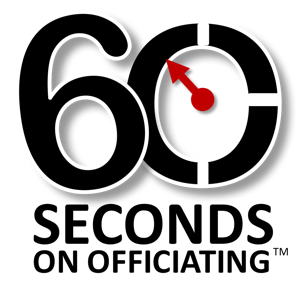
Officials Getting Too Into The Game
You are holding a live ball with the clock running when player A-1 rebounded A-2’s missed free throw that was the front end of one and one.
A-1 believed it was the first of a two-shot foul.
As you, or your partner, stand there with the basketball momentarily in your hands, and perhaps some “egg on your collective faces”, this would be a good time to gently remind you to always stay on guard for the unexpected.
This means finding a realistic balance of focus and attention to detail that falls between being as skittish as a cat on a hot tin roof, and being lulled into a false sense of security due to the uneventful nature of the game and allowing a ‘coast to the finish line’ mindset to creep into your thinking.
An officials’ state of readiness and alertness ebbs and flows from the moment you step out of the car in the gym parking lot, until you slip safely back into the front seat of your vehicle.
So depending on the level of play you’re officiating on, this is about a two-to-three hour window where you need to be monitoring what you say and do walking into the facility, in the locker room and on the court.
Once the game begins, your inner voice needs to be ‘louder’ and channeling your nervous energy to be fully-present in the moment and ready for anything.
Like a player mistakenly tossing you a live ball from a missed free throw.
Now if you are standing out of bounds when you catch the ball tossed by A-1 who rebounded the missed first free throw in a bonus situation, or the ball touches you as you astutely try to avoid it, this would be a violation committed by A-1 and you would award the ball to Team B at the spot right where you are.
However, if the official catches the ball while they are inbounds, a whistle by someone in the crew will undoubtedly follow as soon as the mistake is realized.
The officials should quickly and calmly come together and confirm that it was in fact a bonus free throw situation, and not a two-shot foul, then award the ball back to Team A for a throw in at the closest spot to where the ball was at the time play was halted.
Team A was clearly in possession when play was stopped by the officials, albeit for mistakenly catching a live ball on the court, so this is a resumption of play at the point of interruption situation.
This will require a very brief conversation with both head coaches, by the Referee on the crew or the official who caught the ball, before quickly resuming play and getting back on track.
So if you make a conscious and concerted effort every game to keep your mind on alert and your head in the game, this will go a long way to keep your body from betraying you and getting you too into the game!
NFHS Rule Reference: 4-36-2a

Agreed. Free-throw administration is not a knee jerk. The reporting official first indicates to the non-reporting official(s) how many free throws prior to reporting to the table, then indicates how many free throws to the official scorer and then confirming again with the administering official how many free throws while moving into position for the free throws. This procedure reduces the chances of administering the wrong amount of free throws to the free throw shooter.
I have not run into this exact situation before but……
A) let’s say the ball is tossed to an official who side steps it to avoid the ball – live ball in play right?
B) let’s say the ball is tossed to an official who either fumbles it or reflexively catches it and drops it immediately realizing it’s a live ball in play right? (Assuming there is no crew whistle)
Food for thought certainly
This just happened to me for the first time in my officiating career. It was working a 45+ men’s recreation league game as the trail when A-1 from his front court, mistaking me for a teammate, passed the ball back to me as I was trailing the play. I was too close to move out of the path and instead of quickly turning my torso to deflect the ball, instinct took over and I caught it.
On the smaller court, the backcourt line is the other team’s free throw line but it is not in play until the last two minutes of the game. Where I was positioned on the court, it was not a certainty that the ball would have gone out of bounds or be recovered by either team So my partner and I conferred and awarded the ball to the team with the arrow, leaving us both with a good while unexpected lesson in what to do if it ever happens again.
What are you doing standing inbounds during a free-throw attempt?
The Lead is inbounds when bouncing the ball to the free-thrower. It is also possible that the Lead used the incorrect NCAAW/NBA mechanic for a first free throw of standing below the lowest lane space. Those could explain why the Lead was inbounds.